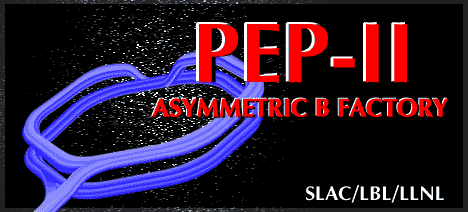 08/06/98 Update
08/06/98 Update
 08/06/98 Update
08/06/98 Update
The LER received most of the attention. The chromaticities were set to positive values. The single bunch current was raised to 5 mA (four times the design single bunch current of 1.3 mA) and was administratively limited due to beam induced voltages on the feedback kicker feed-throughs. We injected beam into every required bucket (1658). A total current of 53 mA was achieved limited by a warm interaction region vacuum chamber (found later to have it's cooling water valved off). The tune shifts with currents were measured and found to be reasonable. 1024-turn BPM measurements were taken and the phase advances between BPMs were studies. A few mis-wired BPMs were found and several small phase errors were seen but are not yet understood. The interaction region betatron functions were measured. The horizontal betas were correct and the vertical betas were within a factor of two. Both LER RF systems with two cavities each were tested successfully.
The LER beam lifetime was at the end 3 minutes. Some lengthening of the lifetime from beam scrubbing was seen. This short lifetime is due to, mostly likley, vacuum pressure. The TSP pumps in the LER at each photon stop were not activated because of, in part, a connector issue with the Ti filaments. This connector problem now has a proven fix which will be fully implemented by the October run. The LER accumulated about 0.5 amp-hour of positron beam.
The HER continued lattice and phase advance studies. The new permanent magnet interaction region commissioned very quickly. The beta functions were as expected. However, the threshold for vertical multibunch instability was lower now than in the January run. Much work is going into studying if the new IR, ions from the high IR vacuum pressures, or several newly installed collimators caused this change.
During the run we collided beams only for two shifts. We succeeded in having stable collisions with one-on-one bunches and 12x12 bunches. Using the two BPMs which see both beams near the IR and the IR position DC bumps, it was straight forward to place the beams into head-on collision. Longitudinally, the bunches were timed correctly to +/- 5 psec. Clear signals were seen in beam-beam deflection scans and in e+e- tune-coupling scans. Signals in the luminosity monitor have not been seen. The stronger beam (e-) could easily affect the lifetime of the weaker beam (e+) if too much charge was injected.
Future plans: August and September are down months for site transformer work. We will commission again in October, November and December maximizing the luminosity and ring performances. As presently scheduled BaBar will roll-on January through March 1999. Commissioning with BaBar will start in April 1999.
Congratulations to all the people who worked so hard to finish the LER and IR installations in July and to the commissioning teams for the performance achievements of both rings and IR. Well done!
Best regards, John Seeman
Suggestions to: John Seeman
[PEP-II Commissioning Updates] [PEP-II Home Page] [BABAR Detector Home Page] [SLAC Home Page]
Page owner: achan